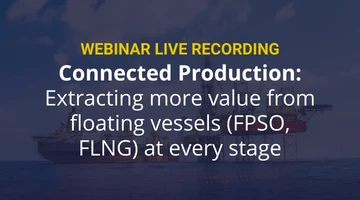Depletion of Oil & Gas Could Spell the End of FPSO
Add bookmark[eventpdf]
Johan Gardin, Senior Principal Surveyor and Director of Offshore Classification, for DNV speaks exclusively to Oil & Gas IQ on harsh weather conditions, the impact of clean energy on FPSOs and the state of the industry in 10 years time.
What are some of the challenges FPSO’s face in harsh weather conditions and what is being done to ensure that the vessels are able to withstand these harsh weather conditions?
The main challenges of harsh weather lie in maintaining uptime (usually 95-98 percent is the quoted benchmark of a successful operation) and avoiding damage. Uptime is threatened for example by forced disconnection and by motions affecting the process or making maintenance and repair difficult. Damage by green seas is well documented from the North Sea and will impact most on forward structures but also further aft by "climbing waves." If the hull design is unfortunate, seasickness may make life on board very difficult. Needless to say, a good hull design and a robust mooring system are required and there are specialists in this field, in particular suppliers of STL solutions. Green sea damage can be mitigated by simple structural strengthening and barriers, although the raw force of the sea seems to be hard to appreciate from within a designer's cubicle.
How does President Obama’s recent drilling plan affect the state of FDPSO in the and around the United States and how will the FDPSO’s change the industry?
It is perhaps a bit early to say; however, I don't think it has much to do with FPSO vs. FDPSO. The first FPSO has just arrived in the USGoM and it took a great while to do it. Successive units will be few. President Obama letting drilling "loose" may of course reduce available rigs / increase day rates, which could make an FDPSO viable elsewhere. But even if not extremely complex, creating an FDPSO is not done on the spur of the moment, and I don't see them becoming industry standard by any means. The FDPSO probably remains a niche solution for remote areas.
In what way will the developments in technology and the focus on clean energy affect the growth of the FPSO sector?
It depends on which technology we consider—sub-sea production technology, for example, is a clear alternative to FPSO when the conditions are right. In the short run, FPSO developments are as we know not yet fully exhausted, although the numbers of "required" FPSO can be disputed. The depletion of oil and gas and rise of cleaner energy spell the end of FPSO in the long run—maybe they can survive as platforms for offshore wind farms.
What is the one key challenge that you see the FPSO industry facing in the short term?
That has to be finance; a strong second might be another insane boom when the Pent-up Needs finally meet up with Risk Capital again.
Where do you see the future of FPSO and FDPSO in 10 years time and how will the current economic climate affect the evolution of the industry?
In 10 years' time, we will probably see the numbers of FPSO peak. The current economics will only affect the industry momentarily; there is still oil and gas in the ground and we have no big-time alternative, so it's either "find and develop the fields" or "park the car permanently."
|
Have Your Say Rate this feature and give us your feedback in the comments section below |












